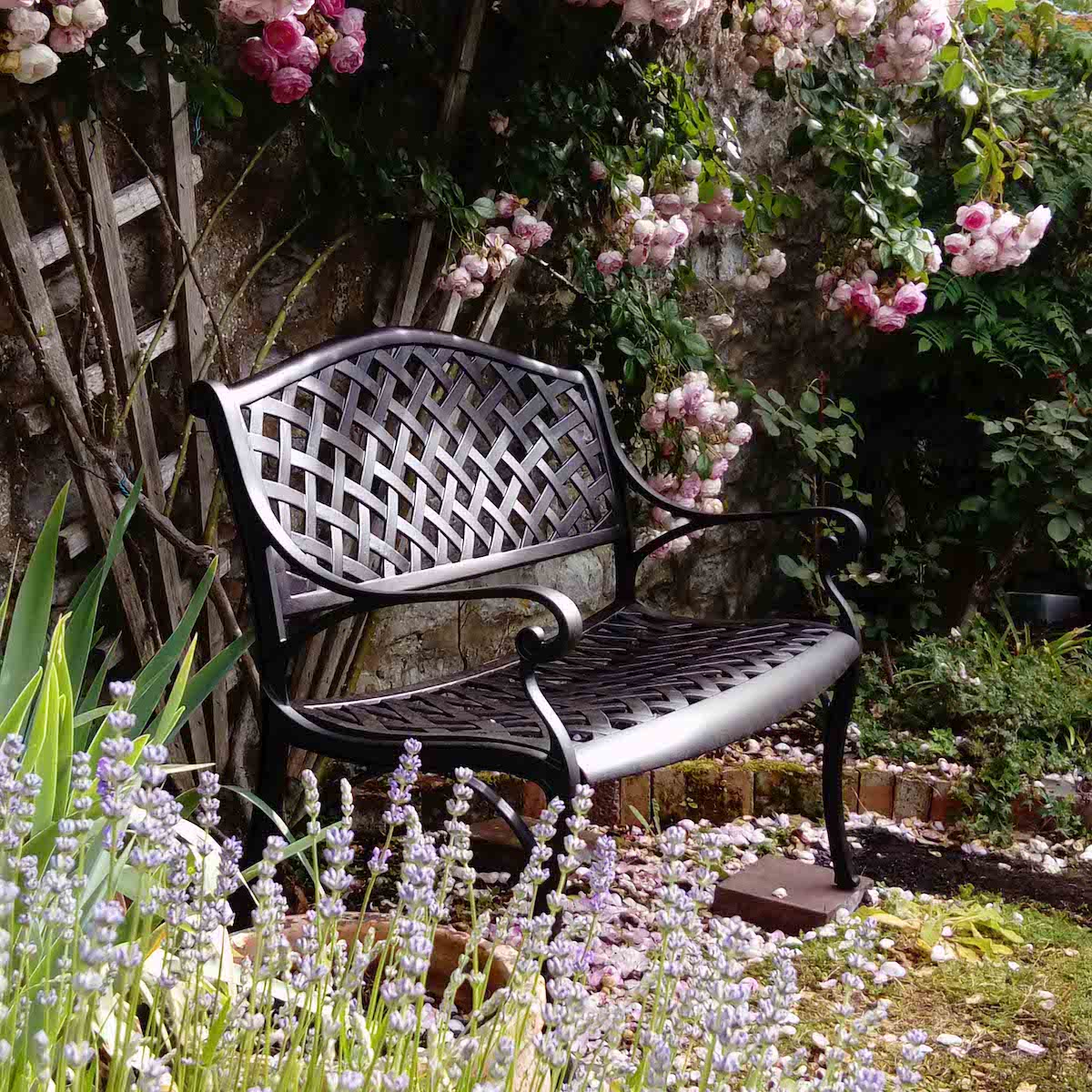Here at Lazy Susan, our focus is on cast aluminium outdoor furniture, however, in the past we have sold other materials such as steel and rattan. We just genuinely believe that cast aluminium is best suited to the UK climate, hence why it is our go-to material.
And one of the primary reasons is that it’s easy to clean and maintain. Anything left outside will get dirty but some materials are just better suited to the elements than others and easier to clean when they inevitably do get mucky!
We know how to clean and maintain cast aluminium but we also know other popular materials and how best to clean and maintain them too. And that’s exactly what we want to explore in this post.
We recently looked at how to look after our furniture (and we will summarise that too) but the Lazy Susan Blog is visited by many and we want it to be a one-stop shop for anything to do with outdoor furniture and the garden.
Early autumn is also the perfect time to get outside and give your furniture a good clean/apply protection before winter takes hold, so the team have got our heads together and formulated cleaning and maintenance routines for each of the popular patio furniture materials on sale in the UK.
How to clean cast aluminium outdoor furniture
Our outdoor furniture range is designed to be left outside all year round. It is constructed from high-grade cast aluminium, which is then painted with a protective finish to protect the metal from the elements.
As we’ve just mentioned, this is something we looked at in our recent how to protect your Lazy Susan outdoor furniture this winter post. However, just to give you a quick overview, our basic cleaning method and tips for our outdoor furniture range are as follows:
- Wash your cast aluminium outdoor furniture
A quick wash with warm soapy water, a rinse off with the garden hose and leave to dry will do the trick. We advise you NOT to use a pressure washer though. They are just too powerful. Warm soapy water will remove the grime, then just rinse with the hose on a spray setting and leave it to dry in the sun. Washing up liquid works OK, but a good car wash and wax-type shampoo is our preference as it removes dirt and grime but won't damage the painted finish. - Remove any stubborn stains from cast aluminium outdoor furniture
Again, don’t be tempted to use a pressure washer. Things like sunbaked bird droppings or tree sap are best softened first to avoid potentially damaging the painted finish. Start by soaking an old tea towel, sponge or microfibre cloth in warm soapy water and let it sit on there for a few minutes or so, then wipe it off. A light squirt of WD-40 is also good for this job. Just leave for a minute or so, and then wipe off with warm soapy water. Alternatively, you could use a car bug cleaner such as Autoglym Active Insect Remover. Again, just leave it for a minute or two, and then wipe it off with warm soapy water. - Apply a light coat of car was when dry
Once clean and dry we always like to apply a light coat of car wax. A basic ‘carnauba’ style wax you’d apply to your car will do the job, nothing expensive. Our preference is Simoniz Original Carnauba Wax as it's easy to apply, not too expensive, and most importantly, easy to "buff" to a nice lustre. It will also provide that all-important protection against the elements and keep the furniture cleaner for longer. You don't need much. Just apply a light coat with one microfibre cloth and "buff" it with another! - Touch up any chips and scratches
It is important that you maintain the painted finish on our furniture. Compromise the integrity and it could lead to problems down the line. If you get a small scratch or a chip on the foot of a chair or table whilst moving it out on a stone patio for example, then moisture could get under the paintwork. This is super rare but it has happened. The solution is just to keep checking, and if you do spot a chip, touch it up with our Touch Up Paint Kits. Our YouTube how-to video shows you the simple step-by-step process. - Cover & secure your outdoor furniture
At this time of year, you might want to think about covering and securing your furniture if you can’t store it in a garage or shed. If you have no choice but to leave outside, then there are two options. Leave it (many do) or cover it. The key with outdoor furniture overs is to ensure they fit, are secured in place and are constructed from a breathable waterproof fabric. You can pick up large covers that will fit over the full set, however, our advice would be to get ‘fitted’ individual covers for each piece from somewhere like Covers & All.
How to clean wrought iron outdoor furniture
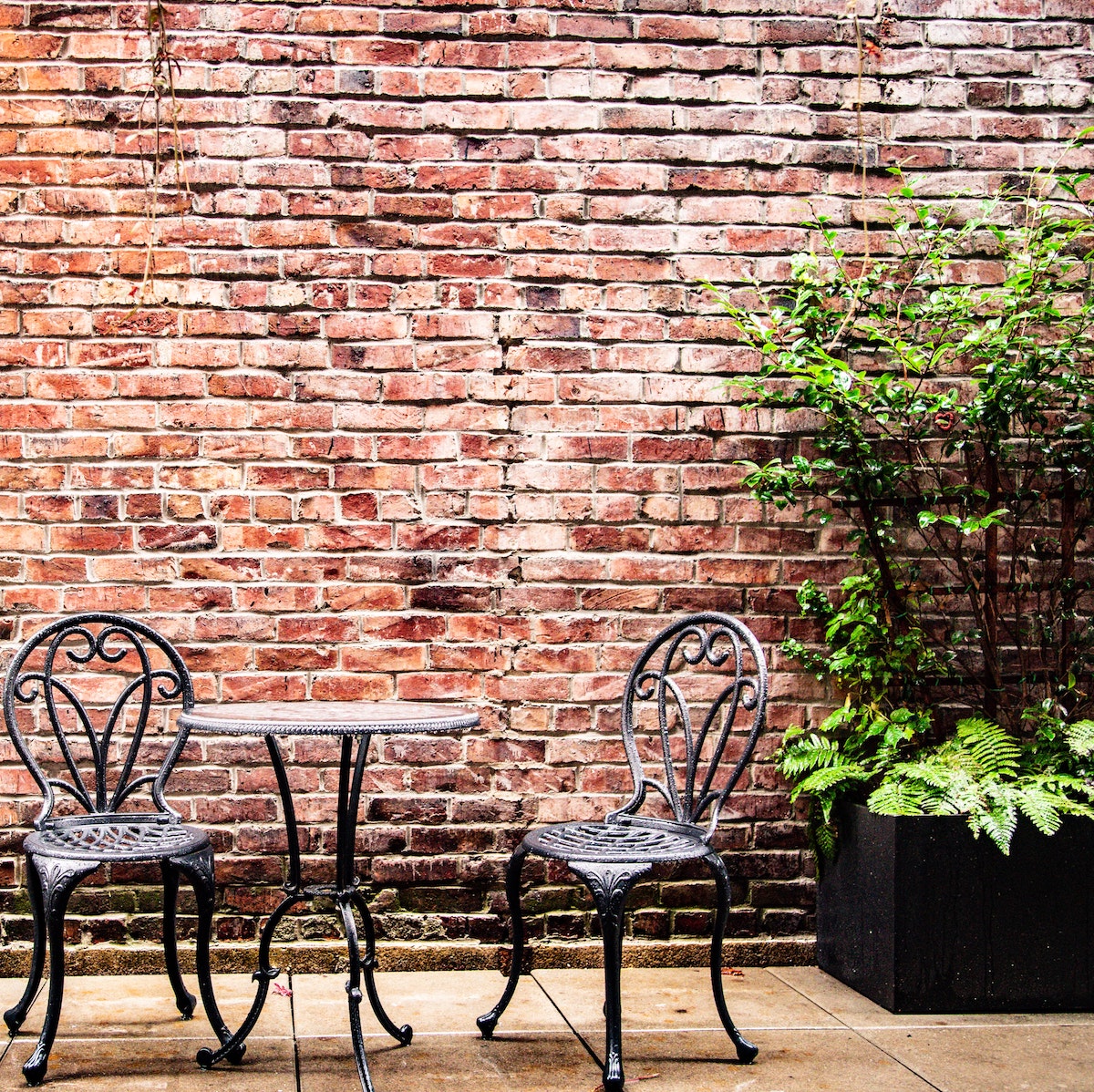
Wrought iron and cast aluminium have much in common. In fact, the pieces often look very similar. Iron has a lot more weight though and is easier to repair if need be but that is also its disadvantage.
It is highly susceptible to rust, especially if it isn’t coated with good-quality paint. Our recommended cleaning and maintenance routine is as follows:
- Brush your wrought iron outdoor furniture
Routine cleaning wrought iron is honestly not much different to cleaning our cast aluminium furniture, the tricky bit is the maintenance needs a little more effort. For a starter, you tend to find it has a rougher surface so dirt and grime stick to it a little easier, so a good place to start is to give a good brush with a soft bristle brush. - Wash your wrought iron outdoor furniture
When it comes to giving it a wash, the same process applies. Give it a good wipe down with warm soapy water (again washing-up liquid or a car shampoo will do the trick) with a sponge or microfibre cloth, making sure you get into all the detail work. Rinse it with the garden hose on a spray setting and leave it to dry in the sun. Again, for any stubborn stains, soak them and avoid using a pressure washer as it could strip the paint off. - Remove and peeling paint and rust spots
Unlike cast aluminium which has more of a sprayed/powder coated style finish, wrought iron paint tends to peel off in larger quantities, so touch-up is a trickier task. If need be, start by scraping away all the loose paint with a paint scraper and clean it up with a hoover. Use a wire scratch brush to remove any peeling paint or any remaining rust. This is a very messy job so always wear eye protection, a dust mask and pop a dust sheet down. Smooth the surface with a medium grit sanding pad. And as the last step, wipe it down with warm soapy water to remove any dust/residue left over and then leave it to dry in the sun. - Repaint your wrought iron furniture
When all the above steps are done and the metal is clean and rust-free, you are ready to paint. If you leave it exposed to the elements it will rust, and it will rust quick. Start by applying a rust-prevention primer such as Hammerite Red Oxide Primer. It is specially formulated for iron and will give you a nice smooth protective base for overcoating without much need for any further sanding. Then apply at least two coats of good quality enamel spray paint. Again, Hammerite has a comprehensive range along with a variety of treatments and solutions to tackle any rust. - Apply a light coat of car wax after cleaning and/or painting
When fully dry we would also advise that you again apply a light coat of car wax for extra lustre and protection. It will help water to better runoff, reduce the risk of rust forming and extend the life of the paintwork.
How to clean steel outdoor furniture
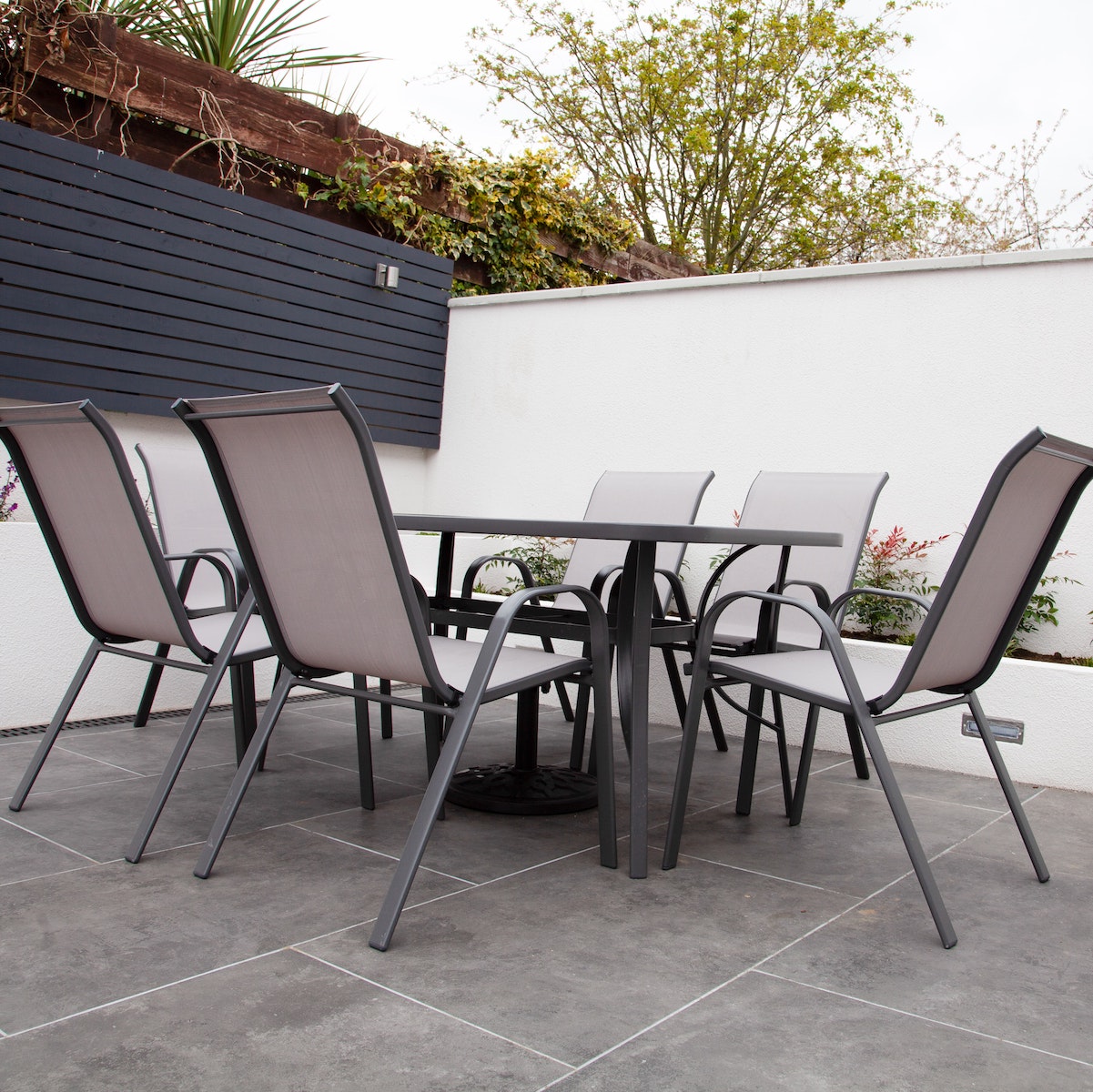
Steel is another popular metal in the UK, and it mainly lends itself to more modern designs. However, much like wrought iron, it is also highly susceptible to rusting and staining.
Both are relatively easy to tackle but they must not be left for too long as that’s when the real problems can take hold. Our general method of cleaning and maintaining steel outdoor furniture is as follows:
- Check what type of stainless steel you have
First things first, steel is a little more unpredictable than wrought iron and cast aluminium, so you need to establish what “series” of stainless steel your furniture is made from and if it is coated with a protective layer/finish. The retailer/manufacturer will be able to confirm this but the reason being is that different types of steel need different types of cleaning and you could damage it. If in doubt, and this goes for any material/any cleaning solution, always test it somewhere that won’t be seen such as the underside of a chair. - How to wash stainless steel outdoor furniture
The best way to clean stainless steel is with an alkaline-based or non-chloride solution or a proprietary solution such as Rock Doctor. Glass cleaner is great if it just needs a quick wipe down. Alternatively, if you want to use what you’re likely to have to hand, then our go-to is to mix a solution in a spray bottle that is 2 cups warm water, 1 cup white vinegar and a few drops of washing-up liquid. Much of the stainless steel furniture in the UK has a “grain” to it too. If yours has lines then always wipe in that direction. Spray on the solution, leave it for a few minutes and then wipe with a damp microfibre cloth. No need to rinse it, just leave it dry when all the dirt and grime is wiped off. - Remove any stubborn stains from cast aluminium outdoor furniture
If you have any stubborn stains such as food, drinks, bird droppings or tree sap then another good trick we’ve picked up is to sprinkle a little baking soda on them and apply the vinegar spray solution. Leave it to fizz for a few minutes and then wipe it off with your soft damp cloth. Avoid scrubbing with anything abrasive as you can leave a 'smooth' spot. - Apply a little extra protection
Even more than cast aluminium or wrought iron, stainless steel benefits from a little extra protection. Car wax is a definite no-no as it is difficult to buff with the grain. You need something a little lighter and baby oil is perfect for this job. Just apply a small amount on a soft cloth and then buff it with a clean/dry cloth. It’ll do the same job as car wax but it will need reapplying more often. Alternatively, there are some great products on the market such as HG Stainless Steel Protector, Shine & Polish.
How to clean plastic outdoor furniture
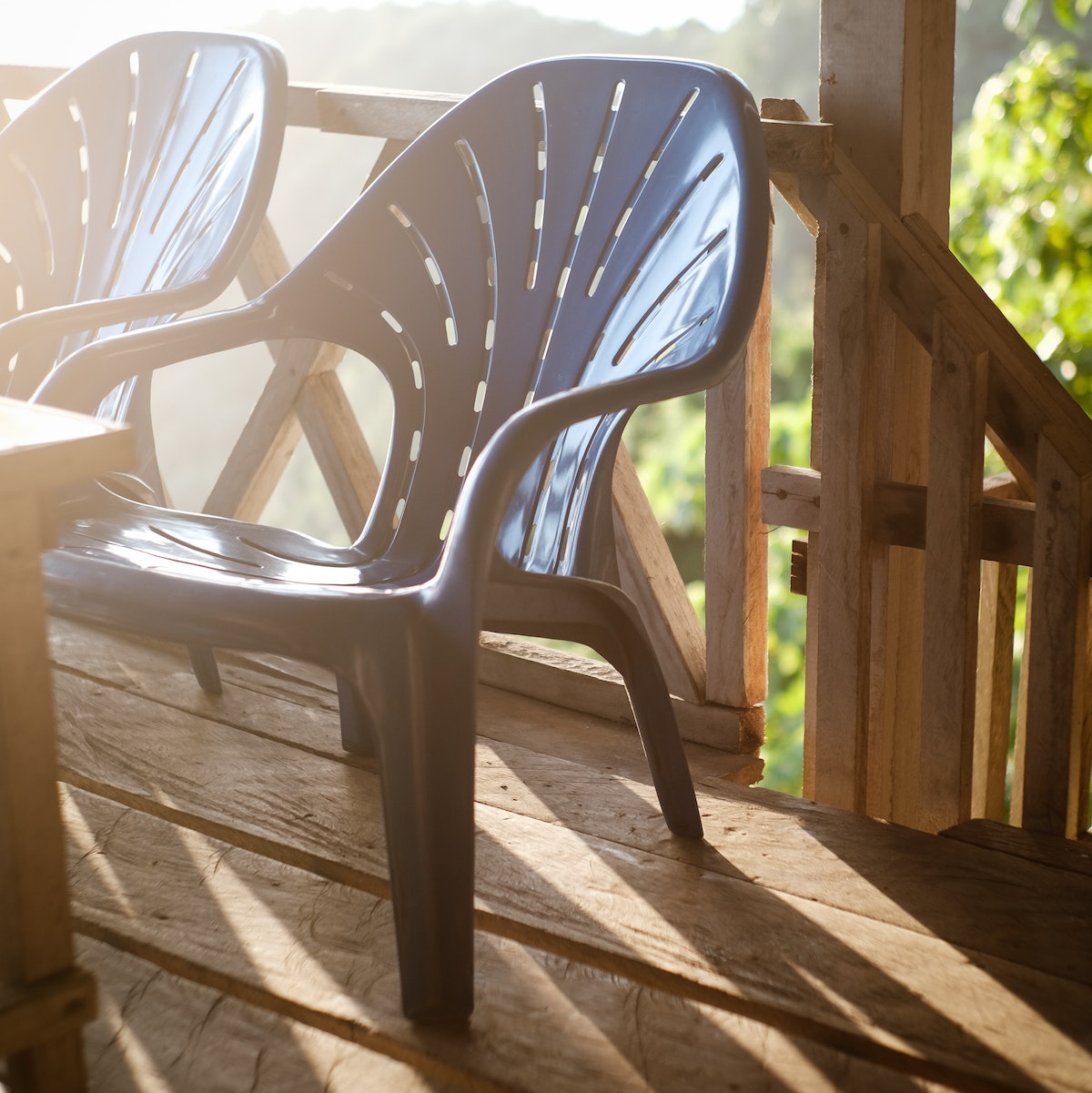
The big advantage plastic furniture has is that it’s easy to clean. On the flip side, if it does get scratched or scuffed, then unlike metal or wood, it is much more difficult (and basically not cost-effective) to repair.
However, it does get dirty and is susceptible to fading in the sun and staining, so it will need a little TLC from time to time to time to keep it looking good, and our technique/tips are as follows:
- Give plastic outdoor furniture a basic wash
Most plastic furniture in the UK is made from either PP (Polypropylene) or HDPE (High-Density Polyethylene but both can be cleaned in the same way. Most are treated with additives to help protect them from the sun but this is mixed in during manufacture so can’t be washed off. If the furniture isn’t heavily stained then you can clean it with warm soapy water (again car shampoo or washing-up liquid is perfect) a soft sponge or cloth and rinse with cold water (again avoid a pressure washer as it can gouge the plastic) and leave it to dry in the sun. - Remove any stubborn stains from plastic outdoor furniture
If the furniture has been left outside for a while and it is looking heavily stained, then a bleach solution can be used too. Mix up 1/4 of a cup of bleach in a bucket of warm soapy water and with a soft bristle brush and rubber gloves, gently scrub the surface. Leave it to sit on the surface for a minute or two and then rinse with the garden hose. Avoid using a pressure washer or any abrasive cleaners/scouring/scrubbing pads as you can easily scratch the surface. - Apply a little extra protection
Once washed and clean, you can also give it a little extra protection by again applying a thin coat of car wax. Just as with our cast aluminium, apply with a dry soft cloth and then buff with another dry cloth. It will help to stop any stains from forming as quickly and provide a little extra protection.
How to clean rattan outdoor furniture
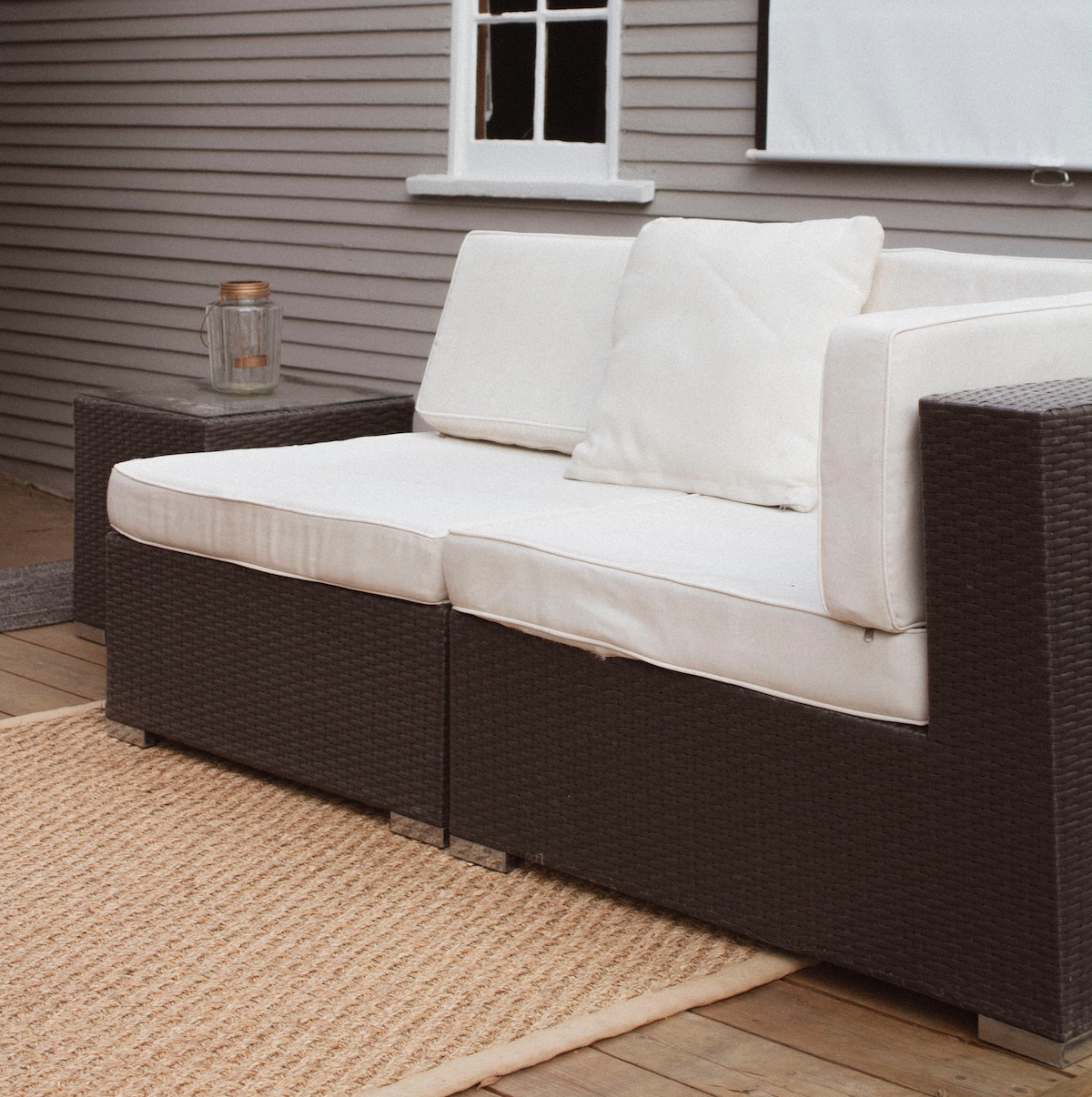
Much of the rattan furniture now sold in the UK features a synthetic resin weave (most of the natural wicker stuff is only suitable for conservatory use) made from a UV-treated PE (Polyethylene) wrapped over a metal frame.
However, it is prone to splitting over time and keeping it clean can be a little tricky as dirt and grime can accumulate between the strands of woven resin. Our method for cleaning is as follows:
- Give it a good hoover
Yes, you read that correctly, on a dry sunny day, get the hoover out and with the brush attachment/nozzle suck up as much of the lost dust and debris as you can. - Wash rattan outdoor furniture
To clean poly-rattan outdoor furniture, all you need to use is a bucket of warm soapy water, a soft sponge or a microfibre cloth. Again, washing-up liquid is perfect, just wipe it down and rinse it with the garden hose on a spray setting. Do not use a pressure washer as this could split the resin and, as with plastic furniture, also avoid using any scouring pads or abrasive cleaners. - Remove any stubborn stains from poly-rattan furniture
If you cannot effectively clean the surface with a simple soap solution then we would recommend using the bleach mix above or a specialist plastic cleaner such as the excellent Plastic Garden Furniture Restorer from HG. If your rattan and wicker garden furniture has been exposed to the elements for a good period of time, then it may require a little extra TLC. - Avoid letting dirt build-up
Exposure to sun, wind and rain will cause dirt to build up on your rattan furniture, so try not to leave it too long. We have heard of the poly weave splitting from a build-up of grime so keeping it clean will help give it a longer lifespan. - Protect poly-rattan furniture
We used to sell rattan pieces but we had issues when people just left it outside without any protection. We discontinued the range as it just didn’t stand up to the elements as well as our core cast aluminium range. That’s not to say all products are the same and we wouldn't want to criticise others on the market. It was just the range we sold wasn’t right for us. However, it does need to be regularly cleaned, and our advice would be to apply a protective spray such as Golden Care’s Plastic Wicker & Textaline Protector as it helps to prevent stains and feeds the plastic to keep it soft/maintain its flexibility for longer.
How to clean wood outdoor furniture
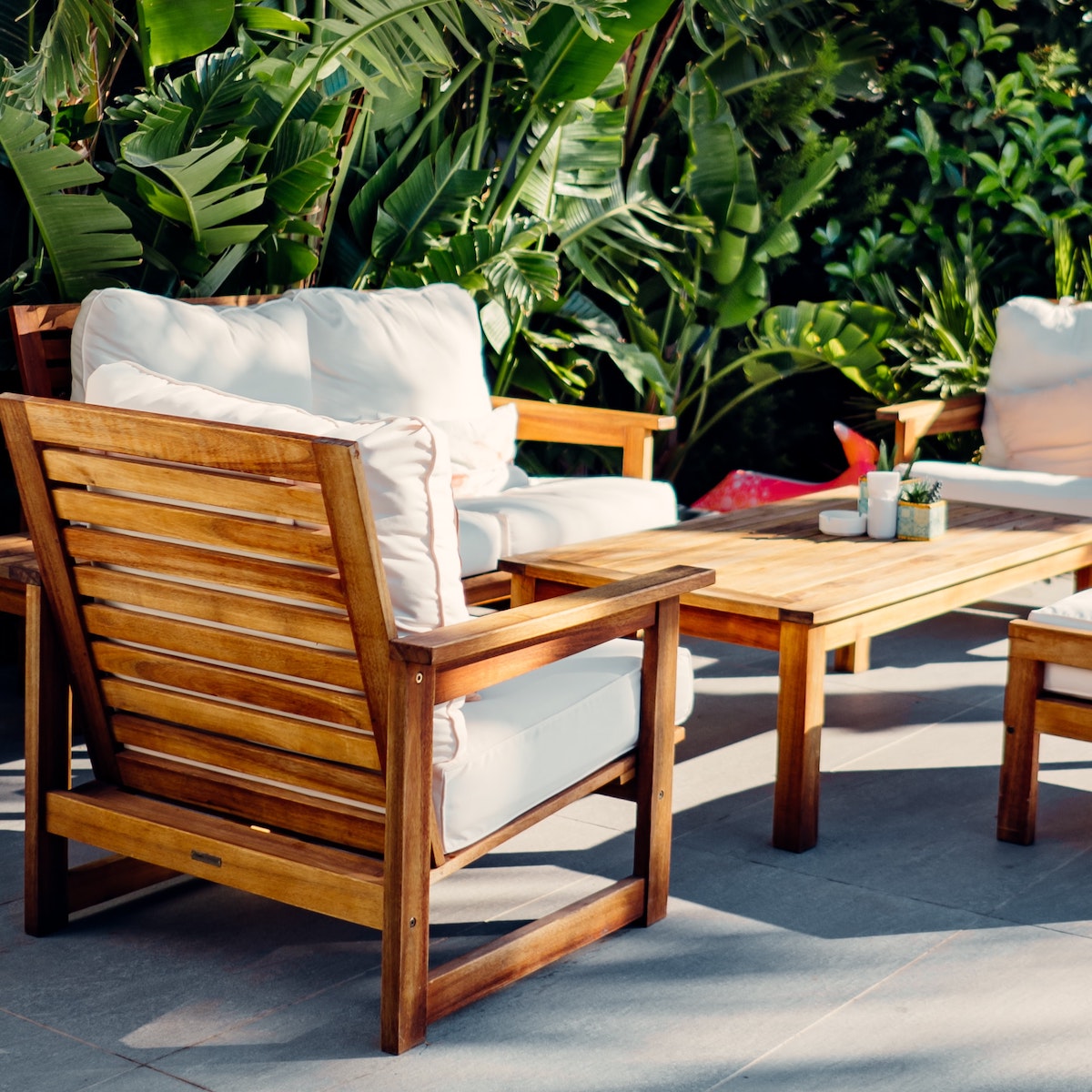
Unlike all of the other materials in our post, which look best when clean, wood (if the quality of the timber is good) can be left to weather. A good quality hardwood like teak for example is one of the best money can buy. It has higher natural oils that help to protect it from the elements.
It really just depends on your preference though. Personally speaking, I’m not a fan of that silvery/grey weathered look but it definitely works in a more rustic/cottage-style setting. However, one thing wooden outdoor furniture will often attract is moss and lichen, and that can be pretty unsightly.
If you want to keep it looking like new, then it is going to take some elbow grease. Not just cleaning but it will potentially need regular sanding, staining and/or oiling to keep it that way too. Our routine for cleaning wooden outdoor furniture is as follows:
- Give it a good wash
The starting point before you think of applying any treatments or finishes is to give it a good clean first to remove all the dirt, moss and lichen. A little washing-up liquid in a bucket of warm water and a soft bristle brush is our go-to for his job. There are a host of specialist wood cleaners on the market too but our advice would be to again test those first on the underside of a chair as they can remove any finish, which is OK if that’s what you plan to do. Once washed, rinse with cold water (again, no pressure washers, they can strip the finish and gouge the wood) and leave to dry in the sun. - Remove any stubborn stains from wood outdoor furniture
If any muck or staining is proving to be a little more stubborn, then a great safe solution you can try is to mix one cup of white vinegar with two cups of warm water and a heaped tablespoon of bicarbonate of soda. Add the mix to a spray bottle and apply. Leave it for a few minutes to fizz on the wood and then scrub with a soft bristle brush. Rinse with the garden hose on the spray setting and leave it to dry in the sun. For any really stubborn stains then the only option that remains is to sand them down and repaint/stain. - Protect the wood with wax, stain, paint or oils
Once clean and dry, this is where you have a decision to make. Regardless of what type of wood, it will need some protection. Each has its pros and cons, so shop around to see which one will give you the desired finish. For example, if the wood is looking a little old and tired, then your best option might be to sand it down and apply a few coats of paint. Alternatively, if it was just a little grubby and the finish is still good a light coat of wax or oil will suffice. - Refinish wooden outdoor furniture
Our how to stain garden furniture article covers all you need to know from prep to application. Clean it first, sand it, apply and leave it to dry. Make sure you wear suitable protection such as a dust mask when applying and tackle the jobs somewhere suitable. Sanding will create a lot of dust so is best done outside, painting and staining are best done either inside or out when there is no wind. - Protect it with breathable covers
Whilst the surface of most metals and plastics can be easily wiped clean, bird dropping or tree sap for example can stain timber. So in the winter if storing in say a shed isn’t an option, then we would advise you to cover your furniture with a breathable cover just to keep it clean more than anything else.
Some of the materials used above are often combined, and this is especially popular with stainless steel where it is combined with timber or resin. When it comes to cleaning mixed material furniture, just make sure you know what it is made from and clean accordingly. If there are any fixed fabrics then you need to be extra careful and stick to safe solutions only (such as washing up liquid).
Outdoor furniture is an expensive purchase, especially if you have one of our larger sets or multiple pieces. Gardens can also be an easy target for thieves as they are easy to access, and furniture is easy to resell. However, if you want to protect your garden furniture, especially when it comes to accidental damage, and for total peace of mind, it is worth taking out or checking your insurance policy to see if it is covered and taking out extra cover if need be.
Always follow the manufacturer/retailer guidelines and if in any doubt, flip over a chair and test first on an inconspicuous area. And regardless of material, prevention is always better than the cure, so keep it clean, protected and cover it or store it in a shed, etc in the winter and it'll last many summers to come.
If you have any further questions about our furniture, please don’t hesitate to contact our Customer Service team or pop a message on our Instagram or Facebook.
If you’ve got any photos of your Lazy Susan garden furniture in situ, then we’d also love to see a few snaps for our Do Some Good charity campaign. You can tag us @LazySusanFurniture on Instagram or Facebook or email them to us at [email protected].




